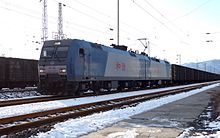Datong–Qinhuangdao railway

Map of the tracks between Datong and Qinhuangdao
Daqin railway (simplified Chinese: 大秦铁路; traditional Chinese: 大秦鐵路; pinyin: dàqín tiělù), also known as the Daqin line (simplified Chinese: 大秦线; traditional Chinese: 大秦線; pinyin: dàqín xiàn), is a 653 km coal-transport railway in north China. Its name is derived from its two terminal cities, Datong, a coal mining center in Shanxi province, and Qinhuangdao, of Hebei province, on the Bohai Sea.
The railway also passes through the municipalities of Beijing and Tianjin. Unlike most other railways in China, which are run by the Ministry of Railways, the Daqin railway is operated by Daqin Railway Company Limited, a publicly traded stock company.

On the Datong–Qinhuangdao line the HXD1 locomotives

C80B open wagon at Datong–Qinhuangdao railway
Daqin railway forms a transport pattern integrating collection, distribution and transport, and shapes up a traffic organization pattern that runs more than 100 pairs of trains at the speed of 80 km/h per day, generating a daily transport capacity of 1 million tons.
The electrified double track line serves as a major conduit for moving coal produced in Shanxi, Shaanxi, and Inner Mongolia to Qinhuangdao, China's largest coal-exporting seaport, from there coal is shipped to south China and other countries in Asia.
The line was constructed in two phases between December 1984 and December 1992, with specifications changed from single-track to double-track during construction.[1] Design capacity was 100 million tonnes a year, which it reached after ten years, but continuous upgrades (wider subgrade, 75 kg/m rails, wagons with higher capacity and top speed, longer trains and stronger locomotives, radio operation and centralised traffic control, automatic train inspection) quadrupled capacity.[2] It carries more coal than any other railway line in China and the world.[citation needed]
Freight trains operating on the Daqin line can carry up to 20,000 metric tons, the largest carrying capacity in China.[3]
In 2006, powerful locomotive models HXD1 and HXD2, with 9.6 MW and 10 MW power output respectively, entered Daqin line to replace the older DJ1 models.
| Year | Coal Transportation Volume (metric tons) |
|---|---|
| ... | |
| 1995 | 20 million[1] |
| ... | |
| 2000 | 60.52 million[1] |
| ... | |
| 2002 | 100 million[2] |
| 2003 | 120 million[4] |
| 2004 | 153 million[5] |
| 2005 | 203 million[5] |
| 2006 | 250 million[6] |
| 2007 | 300 million[7] |
| 2008 | 340 million[2] |
| 2009 | 330 million[8] |
| 2010 | 401 million[9] |
| 2011 | 440 million[10] |
See also
- Coal energy in China
- List of railways in China
- Rail transport in the People's Republic of China
References
^ abc Dadong–Qinhuangdao Railway Construction Project
^ abc Heavy-haul heavyweight
^ Daqin railway starts running heavy-loading train[permanent dead link]
^ Analysis on the High Coal Inventory in Qinhuangdao Port
^ ab Railway company wins approval for public offering
^ Daqin Railway Carried Over 250 Mn-ton Coal
^ Railway Rushed to Transport Power Generation Coal New Type Heavy-loaded Equipments Strut Their Stuff Archived 2011-07-07 at the Wayback Machine.
^ Daqing Railway sees to handle 380 Mt coal in 2010
^ Daqin Railway 2010 Net Profit Up 46% Archived 2011-05-04 at the Wayback Machine.
^ "Review on China's Coal Transport by Railway in 2011". Archived from the original on 2017-06-29. Retrieved 2012-03-29..mw-parser-output cite.citation{font-style:inherit}.mw-parser-output q{quotes:"""""""'""'"}.mw-parser-output code.cs1-code{color:inherit;background:inherit;border:inherit;padding:inherit}.mw-parser-output .cs1-lock-free a{background:url("//upload.wikimedia.org/wikipedia/commons/thumb/6/65/Lock-green.svg/9px-Lock-green.svg.png")no-repeat;background-position:right .1em center}.mw-parser-output .cs1-lock-limited a,.mw-parser-output .cs1-lock-registration a{background:url("//upload.wikimedia.org/wikipedia/commons/thumb/d/d6/Lock-gray-alt-2.svg/9px-Lock-gray-alt-2.svg.png")no-repeat;background-position:right .1em center}.mw-parser-output .cs1-lock-subscription a{background:url("//upload.wikimedia.org/wikipedia/commons/thumb/a/aa/Lock-red-alt-2.svg/9px-Lock-red-alt-2.svg.png")no-repeat;background-position:right .1em center}.mw-parser-output .cs1-subscription,.mw-parser-output .cs1-registration{color:#555}.mw-parser-output .cs1-subscription span,.mw-parser-output .cs1-registration span{border-bottom:1px dotted;cursor:help}.mw-parser-output .cs1-hidden-error{display:none;font-size:100%}.mw-parser-output .cs1-visible-error{font-size:100%}.mw-parser-output .cs1-subscription,.mw-parser-output .cs1-registration,.mw-parser-output .cs1-format{font-size:95%}.mw-parser-output .cs1-kern-left,.mw-parser-output .cs1-kern-wl-left{padding-left:0.2em}.mw-parser-output .cs1-kern-right,.mw-parser-output .cs1-kern-wl-right{padding-right:0.2em}